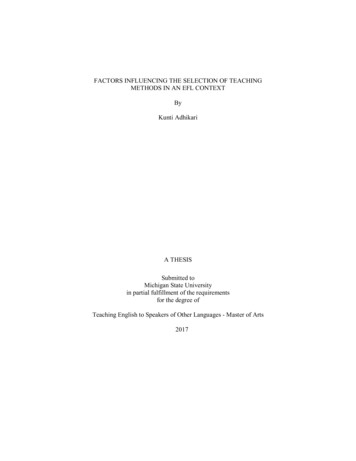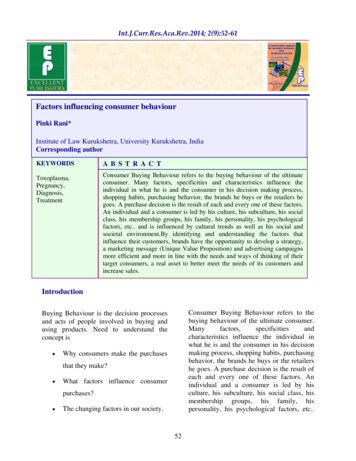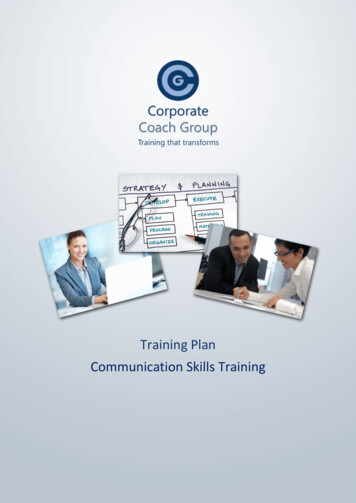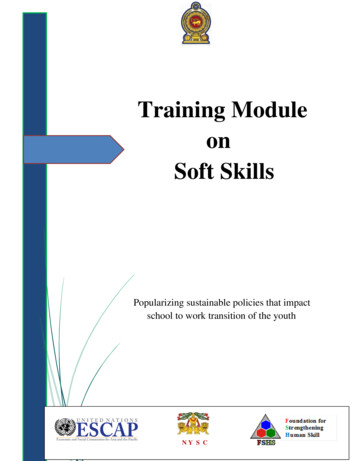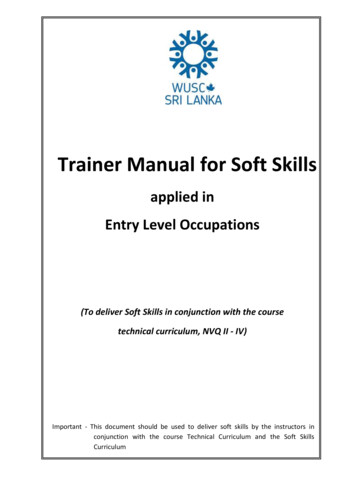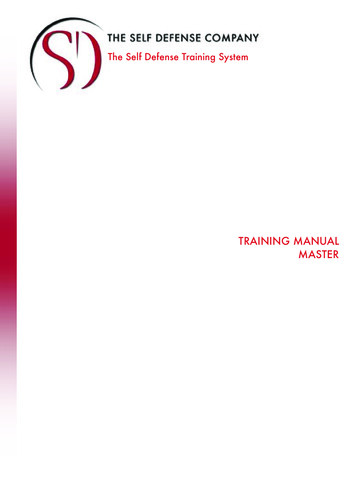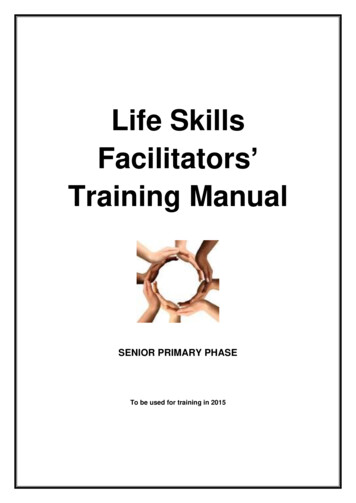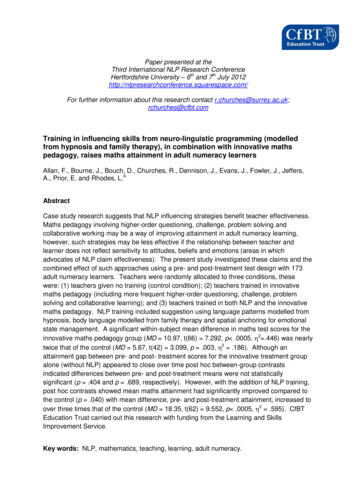
Transcription
Paper presented at theThird International NLP Research ConferenceHertfordshire University – 6th and 7th July or further information about this research contact r.churches@surrey.ac.uk;rchurches@cfbt.comTraining in influencing skills from neuro-linguistic programming (modelledfrom hypnosis and family therapy), in combination with innovative mathspedagogy, raises maths attainment in adult numeracy learnersAllan, F., Bourne, J., Bouch, D., Churches, R., Dennison, J., Evans, J., Fowler, J., Jeffers,A., Prior, E. and Rhodes, L.iiiAbstractCase study research suggests that NLP influencing strategies benefit teacher effectiveness.Maths pedagogy involving higher-order questioning, challenge, problem solving andcollaborative working may be a way of improving attainment in adult numeracy learning,however, such strategies may be less effective if the relationship between teacher andlearner does not reflect sensitivity to attitudes, beliefs and emotions (areas in whichadvocates of NLP claim effectiveness). The present study investigated these claims and thecombined effect of such approaches using a pre- and post-treatment test design with 173adult numeracy learners. Teachers were randomly allocated to three conditions, thesewere: (1) teachers given no training (control condition); (2) teachers trained in innovativemaths pedagogy (including more frequent higher-order questioning, challenge, problemsolving and collaborative learning); and (3) teachers trained in both NLP and the innovativemaths pedagogy. NLP training included suggestion using language patterns modelled fromhypnosis, body language modelled from family therapy and spatial anchoring for emotionalstate management. A significant within-subject mean difference in maths test scores for theinnovative maths pedagogy group (MD 10.97, t(66) 7.292, p .0005, 2 .446) was nearlytwice that of the control (MD 5.67, t(42) 3.099, p .003, 2 .186). Although anattainment gap between pre- and post- treatment scores for the innovative treatment groupalone (without NLP) appeared to close over time post hoc between-group contrastsindicated differences between pre- and post-treatment means were not statisticallysignificant (p .404 and p .689, respectively). However, with the addition of NLP training,post hoc contrasts showed mean maths attainment had significantly improved compared tothe control (p .040) with mean difference, pre- and post-treatment attainment, increased toover three times that of the control (MD 18.35, t(62) 9.552, p .0005, 2 .595). CfBTEducation Trust carried out this research with funding from the Learning and SkillsImprovement Service.Key words: NLP, mathematics, teaching, learning, adult numeracy.
IntroductionNeuro-linguistic programming (NLP) publications frequently claim to have modelled thesubjective experience of highly able people (particularly in relation to communication skills)in a way that enables the transfer of effectiveness both within and across disciplines (seeTosey and Mathison (2009) for an academic appraisal of the field and its development). Theearliest NLP publications originated when Richard Bandler and John Grinder (the cofounders of NLP) were a student and associate professor of linguistics at the University ofSanta Cruz in California in the mid-1970s. Their early books document the use of the NLPprocess of modelling with hypnotherapists and family therapists such as Milton Erickson andVirginia Satir (Bandler and Grinder, 1975a; b; 1979; Bandler, Grinder and Satir, 1976;Grinder and Bandler, 1976). These contain the first publication of their ideas aboutlanguage (verbal and non-verbal), NLP approaches to the investigation of subjectiveexperience and the internal mental processes which people are capable of perceiving. Thefirst book to discuss teachers and classroom practice with NLP appeared in 1982 (Harper,1982), although an earlier publication looked at the development of self-esteem with childrenand teenagers (Anderson, 1981). Robert Dilts then produced a book which contained aspecific chapter on NLP in Education (Dilts, 1983) originally written in 1981. Also in thatyear, Sidney Jacobson published the first of three extensive volumes on NLP and education(Jacobson, 1983; 1986a; b). Over the next 20 years, there have been over 20 morepublications (see Carey et al. 2009 for a detailed review). Drawing on the evidence inrelation to communication skills and teaching (for example, Muijs and Reynolds, 2005) NLPskills have, in recent years, been increasingly associated with the teacher effectiveness(Churches and West-Burnham ,2008; 2009; Carey et al., 2009; 2011; Vieira and Gaspar,2012).From an academic perspective, there has been an increasing interest in research into NLPin recent years with calls for academic commentary to become more evidence based (Toseyand Mathison, 2009) rather than speculative and theoretical. In education, there has been asignificant growth in the publication of research evidence on NLP, and in 2010, CfBTEducation Trust published the first systematic literature review (Carey et al., 2010). Thisreviewed the content of 111 references including studies that contain research evidence.The authors identified 52 papers that claimed to contain confirmatory research evidencefrom 27 qualitative, 7 mixed-method and 18 quantitative education related studies. Thereview identified six quantitative studies that claim disconfirmatory evidence. None of thedisconfirmatory studies was specifically in the area of adult numeracy learning, or classroombased mathematics teaching in general. There were no large-scale classroom basedrandomised controlled trials. Prior to the carrying out of the present research, a furthersearch of the same databases used by Carey and colleagues in 2009 was undertaken.Between 2009 and 2011 an additional 10 education related papers referencing NLP werepublished (el Gany et al., 2010; Carey et al., 2011; Jones, J, 2010; Kudliskis, 2009; Mohsin,2009; Ran, 2009; Salmas-Villarreal, 2010; Saunders, 2009; Sibley, 2009; Slater et al., 2009;Tosey and Mathison, 2010). None of these contained evidence about the effectiveness ofNLP in adult numeracy, or mathematics teaching specifically, however, two studies(Pishghadam et al., 2011a; b) report statistically significant positive correlations betweenteacher success in English language teaching and NLP.With the exception of the NLP Spelling Strategy (Malloy, 1989; Malloy, 1995), most of theevidence in support of using NLP in education suggests benefits in relation to areas likeeffective communication, engagement, questioning and classroom climate rather thanspecific classroom pedagogy. In a perspectives paper on the potential of NLP in educationChurches and West-Burnham (2008), for example, associate the potential benefits of NLP inteaching with ideas about emotional climate and the importance of this for effective learning.
Of particular relevance to this study are the 24 teacher-led action research case studiespublished by Carey and colleagues (2009; 2011). The peer reviewed journal paper (Careyet al., 2011) notes the potential benefits of teachers learning language patterns modelledfrom hypnosis, body language and emotional state management techniques butacknowledges the limitations of evidence provided by small scale teacher-led actionresearch. Specifically, Carey and colleague (2011), recommend a large-scale randomisedcontrolled trial to explore the potential of such techniques. The present study aims to buildon that recommendation.Three recent papers illustrate the need for more research into adult numeracy and effectivepedagogy (McLeod and Straw, 2010; NIACE, 2010; NRDC, 2010). In terms of progress,adult numeracy still lags behind progress in literacy in England (NIACE, 2010). Some of thecontributing factors to this are clear from a recent extensive literature review by the NationalResearch and Development Centre for Adult Literacy and Numeracy (NRDC, 2010). Thisendorsed earlier findings that suggest adult numeracy teaching is both under-researchedand generally lacking a strong theoretical basis (Coben, 2003). The CfBT Education Trustliterature review into Adult Basic Skills also illustrates that there is only a limited researchbase currently in this area compared to other areas of adult learning, particular in relation topedagogy (McLeod and Straw, 2010). The NRDC review looked at academic literature,practitioner-focused publications, government reports and large-scale representativesurveys. The review noted the importance of areas such as students’ self-perceptions oftheir numeracy difficulties (DfES, 2003) and that the gap between assessed and perceivedskills is even greater in numeracy than it is for literacy (Bynner and Parson, 2006). Inrelation to the climate that teachers create in their classrooms, teachers who are effectiveare able to motivate learners to persist (Lopez et al., 2007; Swain et al., 2005) and deal withthe high levels of anxiety and fear that is felt by many adult numeracy learners (Sewell,1981; Meader, 2000). These anxieties often originate from early childhood and can betraumatic and long-lasting (Coben and Thumpston, 1996). Anxiety may also weakenmemory, logical thinking and the ability to work methodically (Ashcraft, 2002). The nature ofthe relationship between the learner and teacher itself may therefore have a significantimpact with effective teachers being sensitive to the attitudes, beliefs and emotions of theirlearners (Cohen, 2005) and by extension it could be argued that adult numeracy teachersneed the skills to deal with these areas effectively. In terms of pedagogy, researchevidence suggests that engagement and making maths meaningful is important (Salford,2000; Baker, 2005) as is the teaching of abstract concepts not just basic numeracy (Swainet al., 2005). Salford, for example, drawing on Piaget argues for a constructivist approach inwhich learners should be allowed to work out the general rules of mathematics fromexploratory situations (Salford, 2000). ‘Bad’ practice is seen as involving the application ofprocedures without understanding (Swain, 2005). High levels of effective questioning,collaboration and engagement in which learners are challenged to think for themselves maytherefore be more effective (see Swain and Swan, 2007). In addition, the need to focus onthe development of effective models for mathematics teaching rather than merely theidentification and recruitment of the most mathematically talented is becoming increasinglyclear across all education phases (Burghes and Robinson, 2009).Principles for more innovative and effective adult numeracy teaching have been defined bythe National Centre for Excellence in the Teaching of Mathematics (NCETM, 2008). Thesebuild on earlier research by Swain and Swan (2007). These principles include the need tobuild on existing knowledge more effectively, expose learner misconceptions, increase theamount of higher-order questioning, more appropriate use of whole class, individual andsmall group work, encouraging reasoning rather than simplistic answering, the use of richercollaborative tasks and the need to make mathematics relate to the real world. The reportalso emphasised the appropriate use of technology, confronting difficulties rather thanavoiding them, greater use of mathematical language and the need to ensure that learners
understand how they have learned things as well as what they have learned. This said therehas not been any controlled research to test these claims.It would appear, from a review of the literature, that achieving effective adult numeracypedagogy might require the inclusion of training that supports teachers to develop moreeffective communication skills (in order to deal with issues of learners’ anxiety, fear andmotivation) as well as the types of effective pedagogy described above. In such a context,communication skills usually found in therapeutic contexts might be useful. Formal clinicalhypnosis is an increasingly established field (see Oakley and Halligan, 2009, for a review ofthe cognitive neuroscience evidence), however, it has also been demonstrated thathypnotic-suggestive communication can have an effect outside of formal hypnosis incontexts such as advertising (Kaplan, 2007). The best predictor of a person’s hypnoticsuggestibility is individual responsiveness to the same suggestions outside of hypnosis(Braffman and Kirsch, 1999). Furthermore, an emerging consensus in the field of hypnosis(Kirsch et al., 2011) acknowledges that: all suggestions experienced following induction canbe experienced without it; that hypnotic inductions only slightly increase suggestibility; andthat waking and hypnotic suggestibility are highly correlated. In relation to NLP one recentstudy also suggested evidence for a relationship between some NLP techniques andhypnotizability. Research by Kirenskaya and colleagues (2011) showed a decrease innegative emotional intensity for both high and low hypnotizables but with autonomic activity(heart rate, skin conduction span) decline observed in high hypnotizables only. Imagevividness and emotional intensity were also significantly higher in the high hypnotizabilitysubjects. Whether NLP represents a sub-school of hypnosis, a set of techniques, or a fieldof study in itself remains a live debate (see Tosey and Mathison, 2009). This study hassought to integrate two domains: NLP influencing strategies; and innovative mathspedagogy including approaches such as higher levels of collaborative learning, challenge,engagement and higher-order questioning - both of which claim benefits, assess theircombined effectiveness and the extent to which the NLP training might enhance effectivepedagogy. Therefore, this research sought to contribute to both the debate about theusefulness of NLP in education and the effectiveness of NLP in general.The present study consisted of a research design with three between-subject conditions anda within-subject pre- and post-treatment maths attainment test. The three conditions were:(1) teachers given no training (control condition); (2) teachers trained in innovative mathspedagogy (involving higher amounts of higher-order questioning, challenge, problem solvingand collaborative learning); (3) teachers trained in NLP influencing skills in addition to theinnovative math pedagogy training in Condition (2). Each adult learner participant grouptook the same maths attainment test pre- and post-treatment. A review of the literature andsubject matter content of NLP training suggested that NLP communication skills wereunlikely to improve maths attainment in themselves if the quality of pedagogy being usedwas in question (because NLP communication skills are essentially content-free). Ratherthere was more likely to be a measurable effect if a baseline of good pedagogy wasestablished and known to be in place. The study’s design therefore allowed for the testing oftwo hypotheses:Hypothesis (a) - adult learners whose teachers are trained in innovative maths pedagogyattain higher maths results than adult learners whose teachers have had no trainingHypothesis (b) - training in NLP influencing skills enhances the maths attainment of adultlearners whose teachers have trained in innovative maths pedagogyMethod
ParticipantsPrior to participant recruitment a priori power analysis was carried out using G*Power 3.1.2(Faul et al., 2007; 2009) in order to estimate a minimum sample size for the study. No priorstudies were available on which to base an effect size estimate. An effect size of 0.1, α 0.05, β-1 0.95 (repeated measures, within-between interaction) was used in thecalculation. Results indicated a recommended sample size of 207. Anticipating substantiallevels of participant attrition, because of the transient nature of adult numeracy classes, therecruitment approach aimed for a target number of 300-350. Recruitment was via e-mailand presentations at networking events and targeted the teachers of adult numeracylearners across the southeast of England. Initially, 37 Further Education sector teachersexpressed interest in participating in the study, 24 teachers eventually took part with 278adult learners completing the initial baseline testing. Offender learning was not eligiblebecause of data sharing issues. As anticipated, there were substantial levels of participantattrition during the study. In addition (to reduce the risk of ceiling effects), the decision wastaken to remove learners who scored more than 95% in the initial pre-treatment maths test.Six learners whose scores were above this cut-off point were withdrawn from the participantgroup following the baseline test. In total, 173 adult learners between the ages of 16 and 70(M 30.94, SD 13.12) completed the study, 71 males and 102 females. The followingnumber of participants completed the post-treatment maths test: no training, n 43; trainingin innovative maths pedagogy, n 67; training in NLP and innovative maths pedagogy, n 63 (see Table 1).Table 1As an incentive, teachers whose classes completed the research could attend a postresearch conference and additional training. There were no incentives for the adult learners.All participants received treatment that was in accordance with standard ethical researchguidelines. Dr Paul Tosey, University of Surrey, was consulted about the ethical applicationof NLP within the research design. The Skills for Life Development Centre, University ofSussex Innovation Centre monitored and controlled all data security, entry and analysis.MaterialsAll adult learner participants received the same pencil and paper single level maths test thatthey completed pre- and post-treatment. Participants also completed a demographicquestionnaire (e.g. age, gender). The maths test was from the Department for Education
and Skills ReadWritePlus Skills for Life Diagnostic tools in Numeracy Testing. The testcovered curriculum areas as specified in the Skills for Life Adult Core Curriculum forNumeracy: Entry 1, 2, 3 and Levels 1 to 3 (DfES, 2001). In addition, participants completedan attitude to maths learning questionnaire, repeated pre- and post- treatment. A furtherresearch paper (currently in draft) will discuss the results from this.ProcedurePrior to the administration of the pre-treatment test and demographic questionnaire theteachers were randomly allocated to one of the three conditions described above, whilstcontrolling for a number of background factors to ensure a similar distribution in eachcondition. The controlled variables were teacher qualification level, number of years inteaching, spread of experience in teaching Skills for Life Numeracy, Functional Maths andKey Skills - Application of Number. No teachers from the same organisation/locationcompleted the same condition to avoid the risk of ‘content sharing’ in relation to the trainingreceived and ‘contamination’ between participant groups.One criticism of NLP is that it is a form of ‘cargo cult’ psychology (Roderique-Davies, 2009).The implication being that any effects are perceptual (or placebo) and exist only in the mindsof converts – although no research has tested this hypothesis yet. In response to thiscriticism, the present study implemented a number of additional controls. All the adultlearners were kept ‘blind’ to the purpose of the study and to the content that their teachershad, or had not, been trained in – the teachers simply adapted their practice without makingany explicit references to anything that they had learned. In relation to the teachers, the notraining group remained ‘blind’ to the content that the other teacher groups had been trainedin and the innovative maths pedagogy alone group remained unaware of the content of thetraining given to the NLP and innovative maths group. Furthermore, the NLP trainedteachers did not know that they were to receive training in NLP until they arrived on the firstday of the NLP training programme. All other participants remained unaware that NLP waspart of the research design. No teachers whose learners completed the study had receivedany previous training in NLP.The adult learners gave consent before completing the pre-treatment maths test, attitudesquestionnaire and demographic questionnaire. Teachers conducted the pre- and posttreatment maths attainment tests in their own classrooms in Further Education, sixth formcolleges, work-based learning providers and adult and community learning providers. Therewas no time limit for the test. Learners could take as much time as they needed to attempt(in one session within one lesson) as many questions as possible before handing in the testpaper. Pre-treatment tests took place in the middle to end of the autumn term and posttreatment tests at the end of the spring term/beginning of the summer term, although exactcontrol of this variable was difficult because of the nature of adult numeracy learning anddifferences in weekly contact time and term dates. Where there was variation this wassimilar within each condition. Teachers themselves received instructions to avoid readingthe maths test and simply to invigilate the test on the two occasions, collect it in and post itimmediately to the project administrator.The three conditions were as follows:(1) No training
Adult learners in this group completed the maths attainment test at the beginning of theallocated time-period and again at the end, their teachers received no training (from theproject) between the two testing points.(2) Training in innovative math pedagogy (involving higher amounts of higher-orderquestioning, challenge, problem solving and collaborative learning)Adult learners in this group completed the maths attainment test at the beginning of theallocated time-period, their teachers then received 2 days of training in innovative mathspedagogy. The principles of effective adult numeracy teaching, as defined in the NationalCentre for Excellence in the Teaching of Mathematics 2008 report (NCETM, 2008), andwhich define a more innovative approach to pedagogy in adult learning, formed the basis forthe curriculum, with a particular emphasis on higher-order questioning: Building on existing knowledgeExposing misconceptionsUsing higher-order questioningAppropriate whole class, individual and small group workEncouraging reasoning rather than answer gettingUsing rich collaborative tasksCreating connection between topics, both within mathematics and to the real worldUsing technology appropriatelyConfronting difficulties rather than avoiding themDeveloping mathematical languageUnderstand what has been learned and howThe training the teachers received also built on ideas and approaches from the Maths4Lifeproject (see Carpentieri et al. (2010), for a summary). Teachers in Condition (2) wereencouraged to use the online adult numeracy resources available at the Learning and SkillsImprovement Service Excellence Gateway throughout the research period. Participants alsoreceived non-NLP related mentoring support to help them to embed the training that theyhad received. This mentoring was carried out by the same mentors who mentored group 3(see below) all of whom were trained to NLP Diploma level but in the case of group 2 werebriefed to avoid using any NLP related techniques. At the end of the allocated time-period,the adult learners completed the same single level maths test again.(3) NLP and innovative maths pedagogy groupAdult learners in this group completed the maths attainment test at the beginning of theallocated time-period, their teachers then received the same innovative math pedagogytraining as Condition (2) above. The teachers also received a further 4 days of training inNLP. The NLP training curriculum consisted of: Learning to use influential language patterns modelled from hypnosis (the Miltonmodel (Grinder and Bandler, 1975b; 1981)) in order to formulate positive suggestionsin relation to attainment, motivation and behaviour (Churches and Terry, 2007).Specifically, the teachers were taught how to create positive presuppositions andsuggestions and how to use: cause and effect and complex equivalence patterns,chained modal operators, double binds, embedded commands, linkage language,pacing and leading, universal quantifiers, yes set and yes tags.Learning to understand the effects of Satir category body language (Blamer,Placater, Leveller, Computer, Confuser) and apply appropriate categories in a
congruent way (Bandler and Grinder, 1976; Bandler, Grinder and Satir, 1976) whilstcommunicating in the classroom (Churches and Terry, 2007). This component of thetraining included foundation training in the development of sensory acuity and theuse matching and mirroring to build rapport (Bandler and Grinder, 1979)Learning to use anchoring to support emotional state management (Bandler andGrinder, 1979) whilst teaching using spatial anchoring (Churches and Terry, 2007)Details of the training protocol are available from nlpresearch@surrey.ac.uk. At the end ofthe allocated time-period, the adult learners completed the same single level maths testagain.Teachers in Condition (3) received additional NLP reading material (Churches and Terry,2007; Terry and Churches, 2008) and the Teaching Influence cards used in previous NLPclassroom case study research (Carey et al., 2010; 2011). They also received mentoringsupport from mentors trained to INLPTA NLP Diploma Level (INLPTA, 2005) to help them toembed the training they had received.ResultsDescriptive statistics show that the mean for the single level maths test improved from 60.37to 66.05 in the no training group; from 54.61 to 65.58 for innovative math pedagogy group;and from 56.49 to 74.84 for the NLP and innovative maths group (see Figure 1 below).Figure 1To address hypotheses (a) and (b) paired-samples t-tests compared pre- and post-treatmentadult learner maths attainment in the three conditions: no training, training of teachers ininnovative maths pedagogy; training of teachers in NLP influencing strategies. Furtheranalysis used a 3 x 2 analysis of variance with post hoc comparisons. Preliminaryassumption testing used SPSS Explore. In relation to carrying out the paired-samples ttests, pre- and post-treatment maths test within-subject data was satisfactory in relation toassumption of normality and the presence outliers. The final analysis applied post hoc testssuitable for use with unequal samples sizes. In relation to the assumptions required for the
analysis of variance and between-subject post hoc comparisons, the pre-treatment dataviolated the assumption of homogeneity of variance, therefore the data was analysed usingthe Games-Howell multiple comparisons test. Post-treatment data was satisfactory inrelation to all assumptions and was assessed using Dunnett’s t.Paired-samples t-tests showed that the improvement in maths attainment in Figure 1 wasstatistically significant for all three of the participant groups: no training, t(42) 3.099, p .003 (2-tailed); training in innovative maths pedagogy, t(66) 7.292, p .0005 (2-tailed);training in NLP and innovative maths pedagogy, t(62) 9.552, p .0005 (2-tailed). Partialeta squared values for all three conditions indicated they could be interpreted as having hada large effect (Cohen, 1998): control (no training), 2 .186; training in innovative mathspedagogy, 2 .446; training in innovative maths pedagogy and NLP, 2 .595. The largeststatistically significant improvement in maths attainment was for the participant group whoseteachers trained in both NLP influencing skills and innovative maths pedagogy. Specifically,the NLP and innovative maths pedagogy group had the highest mean increase of the threeparticipant groups (MD 18.35; SE 1.92) with an increase in maths attainment that wasnearly three times that of the control condition (MD 5.67; SE 1.83) and one and a halftimes that of the innovative maths pedagogy alone group (MD 10.97; SE 1.50). As canbe observed in the data above, and in Table 2 below, innovative maths pegagogy alone alsoimproved attainment with a mean difference score that was nearly twice that of the controlcondition.Table 2However, scrutiny of the confidence intervals for pre- and post-treatment means themselves(Figure 2 and Table 3 below) suggest the increase for the no treatment group would notgeneralise 95% of the time to the population because the post-test score for this group(66.05) lies within the 95% confidence interval for the pre-test mean (lower bound 53.49,upper bound 67.25). This is also the case for the innovative maths pedagogy aloneresults. By contrast, the confidence interval data from the NLP and innovative mathspedagogy groups indicates that the statistical model presented by the data is likely torepresent true values for the population from which the samples were drawn.
Figure 2Table 3A 3 x 2 analysis of variance with repeated measures explored the trend seen in Figure 1,above. The dependent variable was maths attainment. The first factor was the condition(no training; innovative maths pedagogy; NLP and innovative maths pedagogy). Thesecond factor was the timing of the maths test (before or after treatment). Both the maineffect of level and timing (F(1,170) 126.37, p .0005) and the level x timing interactionwere significant (F(2,170) 12.02, p .0005). In order to explore the meaning of the datapost hoc analysis used a series of contrasts comparing the pre- and post-treatmentinteraction with the three conditions. The first set of contrasts explored the differences
between the levels for the pre-treatment maths tests. Because sample sizes for the pretreatment tests were unequal and Levine’s Test of Equality of Error Variance was significantthe Games-Howell multiple comparisons procedure was used. All of the contrasts betweenthe levels were not significant (con
Jul 01, 2008 · NLP training included suggestion using language patterns modelled from hypnosis, body language modelled from family therapy and spatial anchoring for emotional state management. A significant within-subject mean difference in maths test scores for the . Neuro-linguistic programming (NLP

